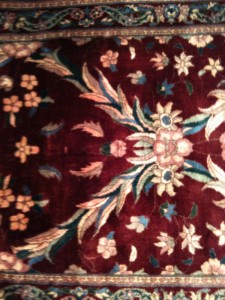Oriental Rug Dyes. What you need to know.
True or false – A colorfast wool rug can bleed?
TRUE.
The rug may be colorfast in CERTAIN situations. For example, with a regular cleaning or wash, with a neutral or acid side cleaning solution, the rug could be perfectly fine. No dye migration (aka “bleeding”).
But, under different circumstances, it could absolutely have dyes migrate and bleed out. Some possible culprits – using high heat, using high pH solutions, keeping the rug wet too long (or in a flood), or exposure to pet urine stains.
True or false – A dye fix/lock/stabilizing solution used by cleaners “sets” a wool rug’s dyes?
FALSE.
The solutions available in our industry for professionally cleaning rugs do not “set” the dyes. They STABILIZE them. This means with wool or silk rugs that are NOT colorfast, but test “stable” with the intended stabilizing solution, that you have a WINDOW OF TIME to clean them. (FYI – with silk rugs that window is MUCH shorter than with wool rugs. You better know what you are doing if you are handling silk, or subcontract the work to a rug plant with silk rug expertise.)
I hear many “salespeople” sharing that you “set” the dyes with this or that.
That is not only inaccurate…
…it is downright DANGEROUS.
A cleaner sent me photos from a job where he applied dye fix on two identical rugs for cleaning. He no problem with the first rug cleaning, using his truck mount. (Which, by the way, you should not use truck mounts to clean oriental rugs period… but I’m not going to get into that right now.)
The heat began kicking in after the first rug was done, and so the matching rug with the same dye fix and the same rug cleaning solution EXCEPT now with added much warmer water – you got this…

Heat is bad for natural fiber rugs
…red dye bleed.
The danger with well-trained professional carpet cleaners deciding to add “rugs” to their services is that their experience with installed carpeting does not transfer to natural fiber oriental and specialty area rug cleaning.
And the solutions, tools, and techniques they own don’t transfer well either.
In the home, heat, alkaline solutions, and the best tools for getting the installed synthetic carpet the cleanest possible, can absolutely ruin natural fiber rugs.
The most common rug problems I’m asked for help with from professional carpet cleaners are 90% due to applying the wrong cleaning techniques to rugs that they do not have the right knowledge about.
And one of the most common results are, dye migration or dye loss or discoloration.
A rug’s value can vary from a cheap $100 Pottery Barn rug to a rug worth millions of dollars.
If you are not sure what you are working on, you might take a little time to find out the basics. And certainly determine the fiber type, and especially the dye stability.
Here are some helpful posts to educate you on dyes:
See below for a video on How To Do A Dye Test
Click here for post Why Some Rugs Bleed
Click here for post Pet Puddles. What To Do To Avoid Damage
I hope you found these reference items helpful. When you know what to look for, and really get the basics of rug cleaning down pat, you can avoid most of the pitfalls that result from the lack of good information (or misinformation) about properly cleaning rugs.
– Lisa
P.S. If you want to learn some of the most common mistakes made by carpet cleaners when cleaning rugs, in the right column of this blog you can opt in for my Rug Disasters Report. I lay out the top 10 most common mistakes I see when handling all of the “help me!” emails that come my way week after week. This is also the way to be on my list for announcements of my upcoming training programs and workshops. (Don’t worry, I HATE SPAM… so you will not hear from me very often, your email will never be rented or shared with anyone else, and it’s super easy to opt-out.)
How To Do A Dye Test
